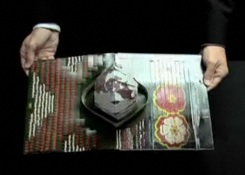Your artist's statement can be a moving testament to your creativity and integrity. The expression of this commitment will vary, but the effectiveness of your artist's statement stems from the authority with which you write it.
Our words "author" and "authority" come from the Latin root "augere," which means "to increase, to create, to promote." This implies that the notions of creation and promotion are compatible! The more I muse on the meaning of working from my authority, of being the author of my work and of my conduct, the more I understand that authentic communication about my work is a powerful tool for creative growth as well as for business success.
The exercises in this section will get you centered and in touch with your own authority. When I write promotional materials for artists (or any kind of business) I always have the principal people involved do these exercises first. I use the words and phrases they generate to compose compelling artist's statements on their behalf. This way their creative authority is incorporated in the finished product.
Think of your artist's statement as a nourishing stew. The rich flavors and inviting aroma will feed your spirit and summon wonderful people to your table. You'll want to make sure your stew is made from the freshest, finest ingredients and that it has been simmered and seasoned with care. Do this, and you will be proud to share your creative vision – your authority – with others.
WRITING YOUR ARTIST'S STATEMENT
You'll need pencil and paper, a dictionary, and a thesaurus.
STEP ONE: Assemble the Ingredients.
1. Take five minutes and think about why you do what you do. How did you get into this work? How do you feel when work is going well? What are your favorite things about your work? Jot down short phrases that capture your thoughts. Don't worry about making sense or connections. The more you stir up at this point, the richer the stew.
2. Make a list of words and phrases that communicate your feelings about your work and your values. Include words you like, words that make you feel good, words that communicate your values or fascinations. Be loose. Be happy. Be real. Think of these as potential seasonings for your stew. You don't have to choose which ones to use just yet, so get them all out of the cupboard.
3. Answer these questions as simply as you can. Your answers are the meat and potatoes of your stew. Let them be raw and uncut for now.
- What is your favorite tool? Why?
- What is your favorite material? Why?
- What do you like best about what you do?
- What do you mean when you say that a piece has turned out really well?
- What patterns emerge in your work? Is there a pattern in the way you select materials? In the way you use color, texture or light?
- What do you do differently from the way you were taught? Why?
- What is your favorite color? List three qualities of the color. Consider that these qualities apply to your work.
4. Look at your word list. Add new words suggested by your answers to the questions above.
5. Choose two key words from your word list. They can be related or entirely different. Look them up in a dictionary. Read all the definitions listed for your words. Copy the definitions, thinking about what notions they have in common. Look your words up in a Thesaurus. Read the entries related to your words. Are there any new words that should be added to your word list?
6. Write five sentences that tell the truth about your connection to your work. If you are stuck, start by filling in the blanks below.
When I work with__________ I am reminded that___________.
I begin a piece by______________.
I know a piece is done when__________________.
When my work is going well, I am filled with a sense of _____________.
When people see my work, I'd like them to ________________.
STEP TWO: Filling the Pot.
Write a three paragraph artist's statement. Keep your sentences authentic and direct. Use the present tense ("I am," not "I was," "I do," not "I did.") Be brave: say nice things about yourself. If you find that you falter, write three paragraphs about an artist whose work you admire. Then write about yourself as though you were an admiring colleague. As a rule, your artist's statement should be written in the first person. Refer to yourself with the pronouns "I, me, my." If this blocks you, write in the third person, then go back and change the pronouns as needed when you get to Step Four. Use the suggestions below to structure your statement. Write three to five sentences per paragraph.
First paragraph. Begin with a simple statement of why you do the work you do. Support that statement, telling the reader more about your goals and aspirations.
Second paragraph. Tell the reader how you make decisions in the course of your work. How and why do you select materials, techniques, themes? Keep it simple and tell the truth.
Third paragraph. Tell the reader a little more about your current work. How it grew out of prior work or life experiences. What are you exploring, attempting, challenging by doing this work.
STEP THREE: Simmering the Stew.
Your artist's statement is a piece of very personal writing. Let it simmer overnight before your reread it. This incubation period will help give you the detachment necessary to polish the writing without violating your sense of integrity and safety. While your statement simmers, let your mind wander over the ingredients you assembled in Step One. Allow yourself to experience the truth of your creative experience. Marvel at the wealth of seasonings and abundance of vegetables you have at your disposal. Enjoy the realization that your work is grounded in real values and experience. If you think of things you might have left out of your statement, jot them down, but leave the statement alone.
STEP FOUR: Taste and Correct the Seasonings.
Read your statement out loud. Listen to the way the sounds and rhythms seem to invite pauses. Notice places where you'd like the sound or rhythm to be different. Experiment with sounding out the beats of words that seem to be missing until they come to mind. Do this several times until you have a sense of the musical potential of your statement. As you read your statement, some phrases will ring true and others false. Think about the ones that aren't on the mark and find the true statement lurking behind the false one. You may find that the truth is a simpler statement than the one you made. Or your internal censors may have kept you from making a wholehearted statement of your truth lest it sound self-important. Risk puffing yourself up as long as your claims are in line with your goals and values.
Keep reading and revising your statement until you hear a musical, simple, authentic voice that is making clear and honest statements about your work. Refer to your word list and other Step One exercises as needed. By now your taste buds are saturated. You need a second opinion. Choose a trusted friend or professional to read your statement. Make it clear that you are satisfied with the ingredients on the whole, but you'd like an opinion as to seasoning. In other words, you alone are the authority for what is true about your work, but you'd like feedback on clarity, tone, and such technical matters as spelling and punctuation. Once you've incorporated such suggestions as make sense to you, make a crisp, clear original of your artist's statement. Sign and date it. Make lots of copies, you will have lots of people to serve it to!
STEP FIVE: Summon the Guests.
There's little point in concocting a fabulous stew if you don't invite anyone to dinner. Every time you use your artist's statement you extend your circle of influence and build new branches of the support network for making, showing and selling your work. Enclose a copy of your artist's statement whenever you send a press release, letter of interest to a gallery or store, or contact a collector. Send it to show promoters and curators. Enclose a copy with shipments of your work so it can be displayed wherever your work is exhibited. The rest of this manual will suggest many opportunities for using your artist's statement to express your truth and support your presentations.
STEP SIX: File Your Recipe!
Save all the notes and drafts that you've made. You'll want to revise and update your artist's statement from time to time to reflect changes in your work.
Still, it is likely that many of the underlying expressions of your authority will remain the same. Having access to the "recipe" for your original statement will help you generate better revisions and will give you a sense of creative continuity. Whenever you need copy (for announcements, packaging, exhibit catalogues, etc.) return to your warm-up exercises. The words and phrases there will help you write openly and honestly about your work. And repeating the exercises will help you chart new creative territory.
* * *









































































.jpg)








